
views
Setting Up the Equipment

Choose a location to give the fluids. Before setting up the equipment, decide where you want to give the fluids. To prevent your cat from escaping, choose a small enclosed space like a bathroom. This area should be free of distractions and away from children and other pets.

Remove the protective packaging. To give subcutaneous fluids, you will need a fluid bag, fluid line, and a needle. Your vet will probably provide you with these supplies. The fluid bag and fluid line will be sealed in their own plastic protective coverings. Carefully remove this covering. Look at the color of the fluid. It should be clear. If it’s discolored and cloudy, do not use the bag. Discolored fluid could indicate contamination. The fluid line will have a roller clamp. Roll the clamp so the fluid line is squeezed together at the clamp. This will keep fluid from flowing through the line when you don’t want it to.
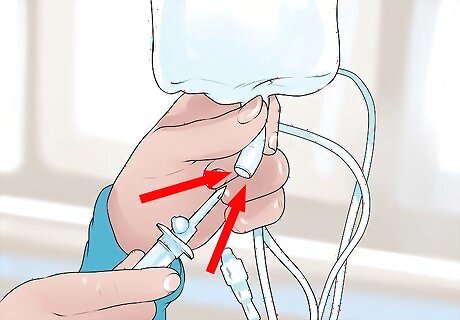
Attach the fluid line to the bag. The top end of the fluid line will have a large spike that will go into the fluid bag’s bottom opening. Remove the spike’s rubber covering and insert the spike into the fluid bag. Do not let the spike touch anything before you insert it. Give the spike a twist to ensure it fits snugly in the fluid bag.

Fill the drip chamber about halfway. The top of the fluid line has a drip chamber that allows you to see how fast the fluid is flowing. Squeeze the fluid bag until the chamber is about halfway full.
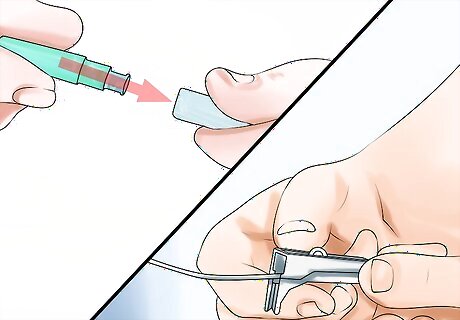
Run fluid through the line. The fluid will flow more easily when it's free of air bubbles. To run fluid through the line, remove the protective cover off the bottom of the fluid line. Loosen the roller clamp and watch the fluid run through the line and out the bottom opening. Do not allow anything to touch the fluid line's bottom opening. This is where the needle will go. Position the fluid line by a sink or trash can so the fluid doesn’t get on the floor. Close the roller clamp after a few seconds so you don’t waste too much fluid. Fortunately, air bubbles won’t hurt your cat. Don’t worry if you don’t get all the air bubbles out, but minimize them as much as you can.
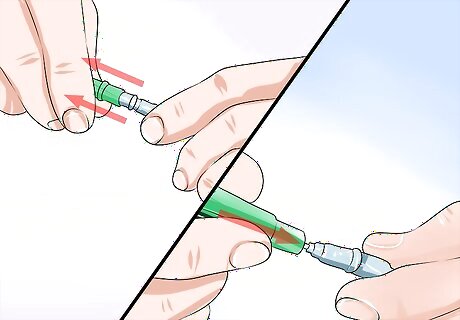
Attach a new needle. The bottom of the needle (where it attaches to the fluid line) may have a plastic covering. Remove this covering if present, and attach the connecting piece on the needle to the bottom opening of the fluid line. The needle will have another covering protecting its top end (the actual needle that is injected under the skin). Do not remove this covering until you’re ready to start giving the fluids.

Hang the fluid bag. The fluid bag will need to hang about three feet above your cat. If you do not have an IV pole, you can slide the top hole of the fluid bag onto a coat hanger. Hang the coat hanger over the top of a door or, if you’re in a bathroom, the shower curtain rod.
Inserting the Needle

Position your cat. Keeping your cat comfortable will help you give it subcutaneous fluids more easily. Position your cat in your lap or on a smooth, flat surface (table, top of washer or dryer). If your cat gets squirmy, considering asking someone else to gently position and hold your cat. Whoever is holding your cat should use gentle restraint. Too much restraint can make a cat want to get away. Make sure the cat is positioned so that it will be comfortable for 10 to 15 minutes. Quietly talking to your cat and petting it will help it feel comfortable after it’s in position to receive fluids.
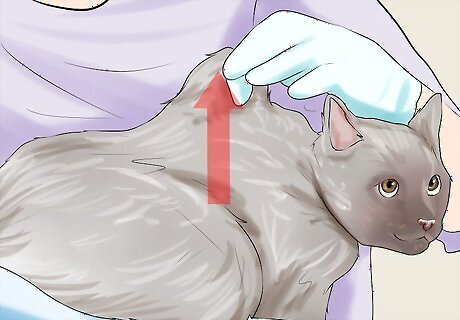
Make a skin tent. To ensure the fluids go under the skin, you will make a skin tent. Choose an area that has a lot of loose skin, such as the shoulders or hips. Using your thumb and another finger, pull up some skin to create the tent. Make the skin tent with your nondominant hand (the hand you don’t write with) so your dominant hand can guide the needle.

Position the needle. Take the plastic covering off the needle. Position the needle so its sharp end is parallel to your cat’s back and facing the skin tent. Make sure the needle’s hole is facing up. Rest the hand holding the needle on your cat’s back.
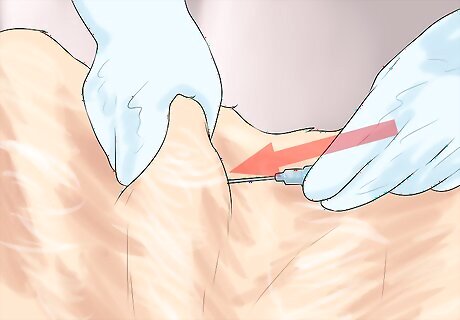
Insert the needle. In one swift motion, move the needle forward until most of the needle is in the tent. When the needle is in, release the skin tent. Because the needle is small and sharp, your cat probably won’t even feel it as it enters the skin tent. As you slide the needle in, make sure you don’t poke the needle in so far that it comes out the other side of the tent.
Administering the Fluid

Open the fluid line. With the needle in the tent, open the roller clamp to allow the fluid to flow. Keep watch on the fluid bag so you administer only as much as your vet prescribed. Before you start the fluids, it may help to mark the bag with a marker so you know when to stop the flow. Each line on the bag represents 100 milliliters of fluid.
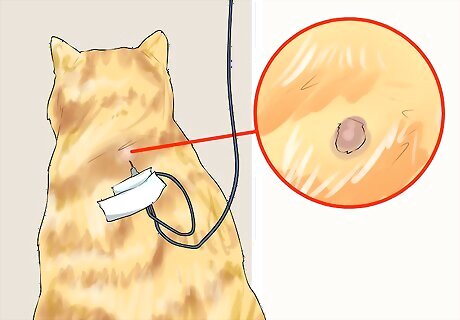
Watch for a lump to form. As the fluid flows under the skin, a lump will form. This is normal. The lump will go down as your cat’s body absorbs the fluid. The lump will eventually get tight with fluid. If you notice the lump is tight but you haven’t given the full amount of fluids, you’ll need to give the rest of the fluids in a different skin tent. Use a new needle if you have to do this.
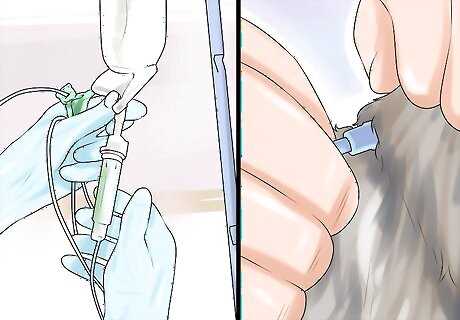
Reposition the needle. Keep an eye on the drip chamber. If you notice the fluid isn’t moving into it, the needle might have moved against the skin, blocking the flow. Gently reposition the needle under the skin without removing it from the tent. You may need to do this a few times to ensure your cat gets all the fluid it needs. You can also try repositioning the needle by slightly rotating the needle in the skin.
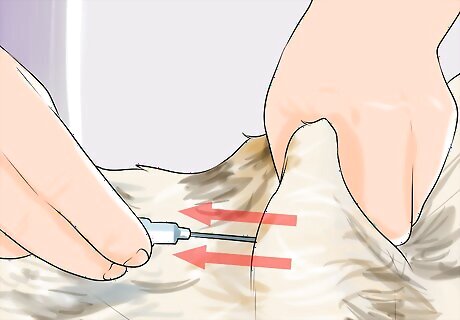
Remove the needle. Once you’ve given all the fluids, close the roller clamp to stop the flow of fluids. Slowly remove the needle by backing it out of the tent. Next, pinch the skin for a few seconds to make sure fluid doesn’t leak out of the tent. You may see a little blood when you remove the needle. A little bit of fluid may leak out as well. This is normal. Take the old needle off and replace it with a new one on the fluid line. Do not discard the old needle in your regular trash. Place it in an area that other pets and children can’t access. Your vet will tell you where to discard the used needles.



















Comments
0 comment